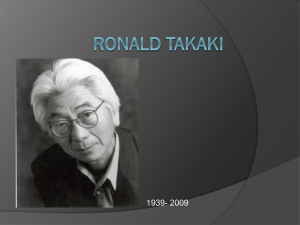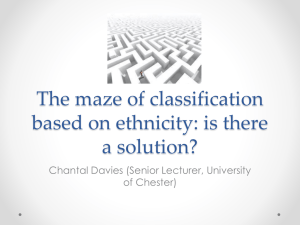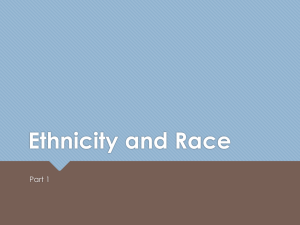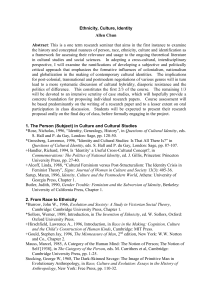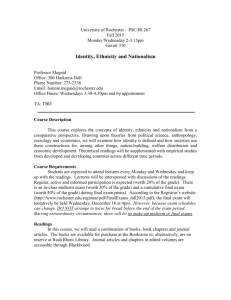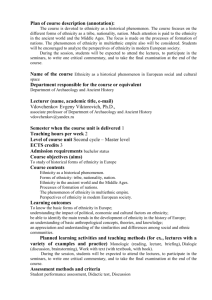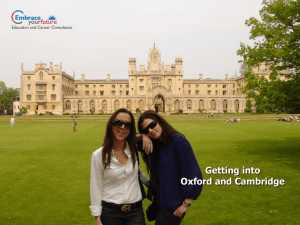The Language of America`s Ethnic Minorities
advertisement
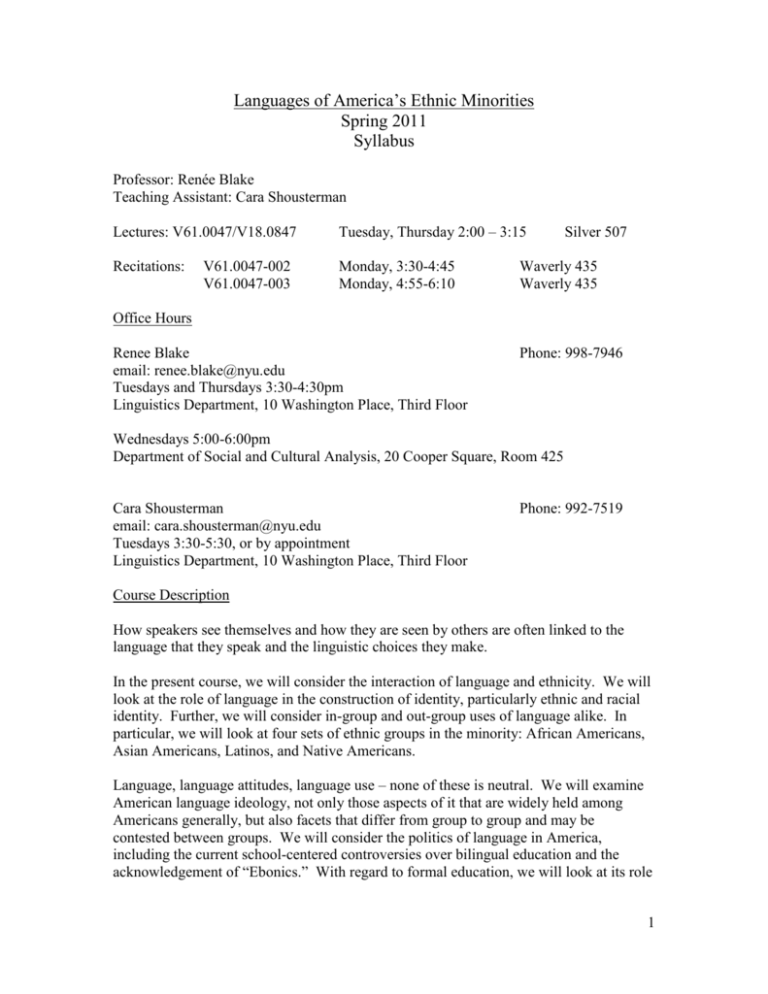
Languages of America’s Ethnic Minorities Spring 2011 Syllabus Professor: Renée Blake Teaching Assistant: Cara Shousterman Lectures: V61.0047/V18.0847 Tuesday, Thursday 2:00 – 3:15 Recitations: Monday, 3:30-4:45 Monday, 4:55-6:10 V61.0047-002 V61.0047-003 Silver 507 Waverly 435 Waverly 435 Office Hours Renee Blake email: renee.blake@nyu.edu Tuesdays and Thursdays 3:30-4:30pm Linguistics Department, 10 Washington Place, Third Floor Phone: 998-7946 Wednesdays 5:00-6:00pm Department of Social and Cultural Analysis, 20 Cooper Square, Room 425 Cara Shousterman email: cara.shousterman@nyu.edu Tuesdays 3:30-5:30, or by appointment Linguistics Department, 10 Washington Place, Third Floor Phone: 992-7519 Course Description How speakers see themselves and how they are seen by others are often linked to the language that they speak and the linguistic choices they make. In the present course, we will consider the interaction of language and ethnicity. We will look at the role of language in the construction of identity, particularly ethnic and racial identity. Further, we will consider in-group and out-group uses of language alike. In particular, we will look at four sets of ethnic groups in the minority: African Americans, Asian Americans, Latinos, and Native Americans. Language, language attitudes, language use – none of these is neutral. We will examine American language ideology, not only those aspects of it that are widely held among Americans generally, but also facets that differ from group to group and may be contested between groups. We will consider the politics of language in America, including the current school-centered controversies over bilingual education and the acknowledgement of “Ebonics.” With regard to formal education, we will look at its role 1 in language socialization, particularly in the language socialization of children in the ethnic minority. Course Requirements Students are responsible for both the readings and the lectures, for materials presented formally in class and in the recitations. Every student is expected to come to class and to the recitations prepared to discuss the scheduled readings. There will be a midterm examination and a final project. In addition, there will be two short papers on assigned topics, each due at the beginning of class on the assigned date. Papers should be typewritten (Times 12 font) and should be double-spaced with one-inch margins on all sides of paper. The topics will be handed out in advance. The exam and papers will be based on the readings and lectures. Note that late papers will not be accepted. Also note that examinations must be taken at the scheduled time. Examinations that are missed will not be excused unless the student provides notification prior to or immediately after the examination with appropriate documentation. Grading Performance and Participation in Class and Recitation Midterm Examination Final Project First short paper Second short paper 15% 25% 40% 10% 10% 100% Readings The assigned articles for the course will be available through Blackboard. Schedule is subject to change. I INTRODUCTION 1/25, 1/27 Brooks, David. 2011. Amy Chua is a Wimp. The New York Times. January 17. http://www.nytimes.com/2011/01/18/opinion/18brooks.html?_r=2 Chua, Amy. 2011. Why Chinese Mothers are Superior. The Wall Street Journal. January 8. http://online.wsj.com/article/SB10001424052748704111504576059713528698754.html? Roediger, David R. 1999. On Autobiography and Theory: An Introduction. in Wages of Whiteness, 3-17. London: Verso. 2 Roediger, David R. 2002. All about Eve, Critical White Studies, and Getting Over Whiteness. in Colored White: Transcending the Racial Past, 3-27. Berkeley: University of California Press. II OVERVIEW 2/1, 2/3, 2/8 Glazer, Nathan. 1994. The Emergence of an American Ethnic Pattern. in Ronald Takaki, ed., From Different Shores: Perspectives on Race and Ethnicity in America, 11-23. New York: Oxford University Press. Fishman, Joshua A. 1988. Language and Ethnicity. in Howard Giles, ed., Language, Ethnicity and Intergroup Relations, 291-333. New York: Academic Press. Garcia, Ofelia. 1997. New York’s Multilingualism: World Languages and Their Role in a U.S. City. in Ofelia Garcia and Joshua A. Fishman, eds., The Multilingual Apple: Languages in New York City, 3-50. Berlin: Mouton de Gruyter. III VOICES OF NEW YORK 2/10 Becker, Kara and Elizabeth L. Coggshall. 2009. The Sociolinguistics of Ethnicity in New York City. Language and Linguistics Compass 3(3): 751-766. Blake, Renée and Cara Shousterman. 2010. Second Generation West Indian Americans and English in New York City. English Today 26(3): 35-43. Voices of New York Website: http://www.nyu.edu/classes/blake.map2001/ IV LANGUAGE ATTITUDES, IDEOLOGY, RACE AND ETHNICITY 2/15, 2/17, 2/22 Takaki, Ronald. 1994. Reflections of Racial Patterns in America. in Ronald Takaki, ed., From Different Shores: Perspectives on Race and Ethnicity in America, 24-35. New York: Oxford University Press. Matsuda, Mari. 1991. Voices of America: Accent, Antidiscrimination Law, and a Jurisprudence for the Last Reconstruction. Yale Law Journal 100. 1329-1407. (Optional) Giles, Howard. 1979. Ethnicity Markers in Speech. in Klaus R. Scherer and Howard Giles, eds., Social Markers in Speech, 251-289. Cambridge: Cambridge University Press. 2/22 Group Project Proposal Due V ASIAN AMERICAN LANGUAGE AND CULTURE 2/24, 3/1, 3/3 3 Wong, Amy Wing-Mei. 2010. New York City English and Second Generation Chinese Americans. English Today 26(3): 12-19. Hall-Lew, Lauren and Rebecca L. Starr. 2010. Beyond the 2nd Generation: English Use Among Chinese Americans in the San Francisco Bay Area. English Today 26(3): 3-11. Chanethom, Vincent. 2010. Influence of American English on Second Generation Lao Immigrant Speakers. English Today 26(3): 20-26. Klein, Wendy L. 2009. Turban Narratives: Discourses of Identity and Difference among Punjabi Sikh Families in Los Angeles. in A. Lo & A. Reyes, eds., Toward a Linguistic Anthropology of Asian Pacific America. Oxford: Oxford University Press. Lippi-Green, Rosina. 1994. Accent, Standard Language Ideology, and Discriminatory Pretext in the Courts. Language in Society 23: 163-197. VI HISTORY OF LANGUAGE POLICY AND POLITICS 3/8, 3/10 Nunberg, Geoffrey. 1989. Linguists and the Offical Language Movement. Language 65: 579-587. Molesky, Jean. 1988. Understanding the American Linguistic Mosaic: A Historical Overview of Language Maintenance and Language Shift. in McKay, Sandra Lee and Sau-ling Cynthia Wong, eds., 1988. Language Diversity: Problem or Resource?, 29-68. Cambridge, MA: Newbury House Publishers. Heath, Shirley Brice. 1992. Why No Offical Tongue? in James Crawford, ed., Language Loyalties: A Source Book on the Official English ControversyI, 20-31. Chicago: The University of Chicago Press. Hayakawa, S.I. 1992. The Case for Official English. in James Crawford, ed., Language Loyalties: A Source Book on the Official English ControversyI, 94-100. Chicago: The University of Chicago Press. 3/10 First Paper Due —SPRING BREAK MARCH 14-18— VII LATINO LANGUAGE AND CULTURE 3/22, 3/24, 3/29, 3/31 Zentella, Ana Celia. 1997. Growing Up Bilingual. Chapters 1-4. Malden, MA: Blackwell. 3/31 Review for Midterm 4/5 MIDTERM 4/7 Project Work Day 4 VIII AFRICAN AMERICAN LANGUAGE AND CULTURE 4/12, 4/14, 4/19, 4/21 Rickford, J.R. 1999. Phonological and Grammatical Features of African American Vernacular English (AAVE). African American Vernacular English. 3-11. Oxford: Blackwell. Labov, William. 1972. The Logic of Nonstandard English. Chap. 5 of Language in the Inner City: Studies of Black English Vernacular, 201-240. Philadelphia: University of Pennsylvania Press. Smitherman, Geneva. 1981. What Go Round Come Round: King in Perspective. Harvard Educational Review 51: 40-56. Baugh, John. 1988. Language and Race: Some Implications for Linguistics Science. in Frederick J. Newmeyer, ed., Language: The Socio-cultural Context, 64-74. (Linguistics: The Cambridge Survey, Volume IV.) Cambridge: Cambridge University Press. Word. The Online Journal on African American English: http://AfricanAmericanEnglish.com VIIII NATIVE AMERICAN LANGUAGE AND CULTURE 4/26, 4/28, 5/3 Basso, Keith H. 1972. To Give Up on Words: Silence in Western Apache Culture. In Pier Paolo Giglioli, ed., Language and Social Context, 67-86. Harmondsworth, Middlesex, England: Penguin Books. Hinton, Leanne. 1994. The First Five Chapters of Flutes of Fire: Essays on California Indian Languages, 20-69. Chap.1(with Yolanda Montijo): Living California Indian Languages. Chap.2: Song: Overcoming the Language Barrier. Chap.3: Coyote Talk. Chap.4: Upriver, Downriver: The Vocabulary of Direction. Chap.5: Language and the Structure of Thought. Berkeley: Heyday Books. Meek, Barbara. 2006. And the Injun goes “How!”: Representations of American Indian English in White Public Space. Language in Society 35(1): 93-128. (Optional) Trechter, Sara. 2001. White between the Lines: Ethnic Positioning in Lakhota Discourse. Journal of Linguistic Anthropology 11(1): 22-35. 4/28 5/5 Second Paper Due Final Presentations 5

